These remarkable James Webb Space Telescope images show stars, galaxies, and space in all their sparkling glory.
The warped, fisheye-like effect in this image is the result of what’s called gravitational lensing. A massive object in the foreground—a cluster of galaxies—is distorting the space-time around it. As light travels through that warp toward JWST, it bends, causing the appearance of streaks and arcs.JWST’s Mid-infrared Instrument can sense the gas patterns, arranged here like the strands of a cobweb, within a galactic structure.
JWST’s Near-Infrared Camera captured our solar system’s glowing gas giant, whose rings shine a million times fainter than the planet itself.In the first publicly released image taken by JWST, the galaxy cluster known as SMACS 0723 is a swarm of stars and spirals. Thanks to the lensing effects of gravity, JWST was able to detect super-distant galaxies—some shown here are from the universe’s first billion years.Life as we know would be impossible without the element carbon.
NASA, ESA, CSA, STScI, M. Tiscareno , M. Hedman , M. El Moutamid , M. Showalter , L. Fletcher , H. Hammel ; image processing by J. DePasquale This protostar is a hot mass of gas that’s drawn into a central core. Once that core is sufficiently dense and scorching, it will trigger nuclear fusion, becoming a sun.This unevenly shaped galaxy, about the same size as the Milky Way, shows the scars of a collision.
United States Latest News, United States Headlines
Similar News:You can also read news stories similar to this one that we have collected from other news sources.
 James Webb Space Telescope captures spectacular image of nearby stellar nurseryThe stellar nursery in the Rho Ophiuchi cloud complex features about 50 young stars, all similar to Earth's sun or smaller.
James Webb Space Telescope captures spectacular image of nearby stellar nurseryThe stellar nursery in the Rho Ophiuchi cloud complex features about 50 young stars, all similar to Earth's sun or smaller.
Read more »
 James Webb Space Telescope: New image of star being born marks 1 year of photosOne year ago, we began getting some remarkable new images of the final frontier. The James Webb Space Telescope began showing us outer space in greater details than ever before.
James Webb Space Telescope: New image of star being born marks 1 year of photosOne year ago, we began getting some remarkable new images of the final frontier. The James Webb Space Telescope began showing us outer space in greater details than ever before.
Read more »
 Out-of-this-world galaxy image from James Webb Space Telescope marks anniversary of servicePhotons lost in space for 13.8 billion years were stopped in their tracks by a thousand-angstrom thickness of gold coating the 25 square meters of the James Webb Space Telescope, producing out-of-this-world images of the most distant galaxies detected to date.
Out-of-this-world galaxy image from James Webb Space Telescope marks anniversary of servicePhotons lost in space for 13.8 billion years were stopped in their tracks by a thousand-angstrom thickness of gold coating the 25 square meters of the James Webb Space Telescope, producing out-of-this-world images of the most distant galaxies detected to date.
Read more »
 NASA selects new head of science for the James Webb Space TelescopeThe longtime agency insider has a distinguished career at NASA.
NASA selects new head of science for the James Webb Space TelescopeThe longtime agency insider has a distinguished career at NASA.
Read more »
 NASA's James Webb Space Telescope celebrates first anniversaryNASA celebrated the first anniversary of the James Webb Space Telescope Wednesday by releasing a new image.
NASA's James Webb Space Telescope celebrates first anniversaryNASA celebrated the first anniversary of the James Webb Space Telescope Wednesday by releasing a new image.
Read more »
